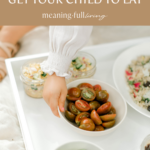The Ramekin Trick for Feeding Your Picky Eater: Fun and Easy Ideas to Get your Child to Eat
If you’re a parent of a picky eater, you know the struggle. Getting your child to eat healthy can be tough! But don’t worry, we’ve got you covered. In this article, we break down the ramekin trick for feeding your picky eater. This is a fun and easy way to get your child to eat more food without making a huge fuss.

The Ramekin Trick for Feeding Your Picky Eater: Fun and Easy Ideas to Get your Child to Eat
Written by: Jessica Diamond, MPH, RDN
Here’s one of our favorite mealtime hacks: serve your child’s food in ramekins! (Shop our favorites here!)
Putting small portions of food on your kid’s plate and serving the rest in ramekins – or any smaller bowls – is great for a few reasons.
First, putting too much food on your child’s plate can unintentionally overwhelm them and lead to more picky eating, especially for new eaters and selective eaters. This is because kids’ serving sizes are much less than ours. For example, a typical serving size of fruits and vegetables for a toddler is 1 tablespoon per year of life, meaning a 2-year-old can meet their serving size with 2 tablespoons. Some kids will eat way more than that, while others will eat way less than that, and that’s fine! But starting with an approachable portion is way less overwhelming for them and much more age-appropriate. And with the ramekins (or family-style meals), you can keep filling their plate as they desire. It also leads to a lot less food waste!
Second, letting your child serve themselves from the ramekins builds fine motor skills and independence at mealtime! Let them eat and serve themselves with utensils (and without) in any order they want. The more they get to practice independence, the more confident they become. This reduces the burden on you long-term because you’re not so physically tied to them during meals and they learn to enjoy meals so much more. Not to mention, they will feel more autonomy over eating, which leads to more intuitive eating down the line.
Third, serving food in ramekins mimics family-style meals, which have a ton of benefits! The presentation helps your child see exactly how much food they have left, which helps with pacing and intuitive eating. It also gives your little one practice having communal dinners, where everyone can connect over a delicious meal.
Disclaimer: We know that serving small portions in ramekins is not possible with packed lunches. For daycare or school, it’s okay to serve bigger portions!
Getting the Serving Sizes Right
Now let’s talk serving sizes! Babies, toddlers, and young kids are actually very skilled at self-regulating. When they are given satisfying meals and snacks, they know how much to eat to grow in the way that’s right for their body. So, we don’t want you restricting food or encouraging your kid to finish one food item before they can get the next one. Messages like “One more bite of your broccoli and then you can have pasta” makes them eat based on your approval, rather than their hunger cues. We like to dial down the pressure by serving them an age-appropriate portion and saying, “You can have as much or as little as you want.”
Always start with less and then let them ask for more. They don’t need as much as you think! Their portion sizes are about ¼ of ours. This might look like offering a ramekin full of strawberries and serving them more out of the ramekin when they ask. Once they’re out of strawberries, you can say, “There’s no more strawberries on the menu, but you can have as much or as little of the other foods there.”
If they don’t eat as much as you would expect, don’t panic! We measure a child’s intake over a week or two and not day to day because their intake varies widely as they grow. Research also shows that if typically developing children lack protein or other nutrients, they’ll even it out on their own over time – they have an innate ability to self-regulate how much food they need.
Are They Still Hungry?
If your child is still hungry after all the food is gone, you should honor their hunger and offer more food. But if they have been sitting for a while and you need the meal to end, you can offer them a meal stopper – something they typically don’t touch or prefer. In our house, that was eggs or cheese for a while. It was one of those foods that was typically avoided unless our kid was still hungry and it was what was served. If they are still hungry, they will eat it, and if not, they will move on.
If meals are going long, it’s totally fine to end them after a reasonable amount of time. Tell them that the meal is almost over so they can take the last bites they want. We try for 3 warnings: a 5-minute, 3-minute, and 1-minute heads up.
If they are done right when they sit down, have them check in with their belly to see if they are hungry. Be sure to communicate the timeline so they can make an informed decision: “It’s lunchtime now, and it’s ok if you aren’t hungry. But there won’t be any food until XX o’clock, okay?”
More to Chew On
Check out some of our other resources for how to bring harmony back to mealtimes and raise an independent and intuitive eater!
- Listen to our podcast episodes, What to Do When Your Child Refuses a Meal & Picky Eating and Mealtime Struggles: How to Bring Harmony to the Dinner Table
- Download our freebie: Tips for Raising Less Picky, Intuitive Eaters
- Read Picky Eating: Serving Food You Think Your Kid Won’t Eat
- Read What to Do When Our Child Refuses a Meal or Item Served
And if you have a baby, take our Feeding your Baby Solids Course. It covers all the topics and answers questions you didn’t even know you had. The best part is it’s all broken down into short, easy-to-understand videos for you to watch on your own time and at your own pace, even while doing the dishes. It will help you thrive when feeding your little one, we promise! For babies 3+ months old.






